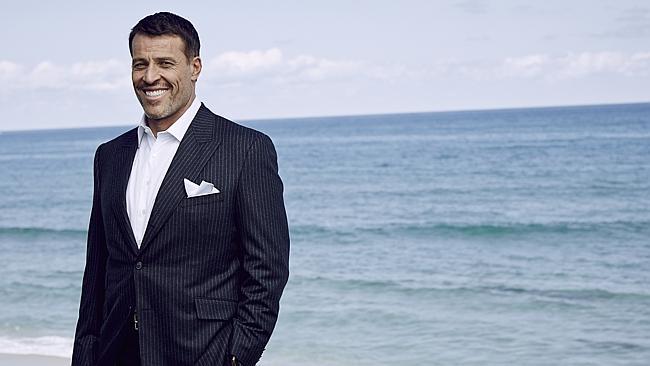Tony Robbins: CEO whisperer says get to know all your staff
That’s how to get the best results, says ‘CEO whisperer’ Tony Robbins.

If a company leader wants to get the best results from their staff, the most effective way to ensure they are motivated, engaged and working towards a common goal is by getting to know each individual and learning what drives them.
According to Tony Robbins, the high-profile peak-performance strategist, leaders need to understand the motivations of every staff member if they want them to succeed or their business to move forward.
“How you influence people to perform at a higher level is if you know what already influences them,” Robbins says. “What are their aspirations, what are their fears? The best executive today is a psychologist.”
Robbins, dubbed “the CEO whisperer” by Fortune magazine, is arriving in Australia tomorrow to speak at the National Achievers Congress in Sydney on Wednesday and Thursday. He will then head to the Gold Coast for other speaking commitments.
While he does not like to be called a motivational speaker, Robbins spends much of his time delivering inspirational speeches to audiences and individuals, and has worked with US presidents including Bill Clinton, sports stars such as 18-time grand slam winner Serena Williams and media mogul Oprah Winfrey.
Robbins previously has revealed that Clinton called him for advice the night before he was impeached in 1998 — and others in power regularly call him for personal counselling.
In 2001 he appeared alongside Jack Black in Bobby and Peter Farrelly’s film Shallow Hal, and while his role was a cameo, his messages on behaviour change and seeing the inner good in people provided the moral of the story. The film may have been a one-off for Robbins, but the message about understanding and accepting other people’s motivations is enduring.
A recent international Gallup poll, which found fewer than 23 per cent of employees were engaged and 25 per cent were actively disengaged, should be a wake-up call for companies, Robbins says, because a leader cannot get the best out of their staff if workers are not engaged.
He says there are three ways to motivate people commonly used in society, whether it be at home or at work.
The first is through fear, but Robbins says people stop fearing threats after awhile and they can backfire.
The second is through incentives. But Robbins says companies can run out of money when offering financial carrots, and there are only so many other incentives they can provide. Incentives have limits, and they can result in people working only to meet a certain standard rather than regularly trying their best in their particular role.
The charismatic American says the best way to motivate staff is by offering them autonomy.
“If you offer self-development and growth, that’s when people become inspired,” he says.
“That’s when engagement goes through the roof.”
He says a great leader no longer looks at staff as a collective but will look at individuals and what they can do to motivate them to work towards a common goal. Knowing what motivates each staff member can help an employer tailor non-financial incentives, such as allowing people time off to work for charities.
“It makes them feel good about their work and doing something that gives them meaning in their life,” he says.
Robbins says part of that motivation is finding out how a staff member defines themselves and what they do. Is their daily job just work, or is it their career or even their mission?
Those who work turn up each day and go through the motions, living to go home, earning money to fund a lifestyle and family, and spend more time thinking of being elsewhere. They are undertaking a daily activity without real purpose and are likeliest to be in the percentage of staff who are disengaged.
Those who have a career are likelier to be invested in what they do, and those who have a mission have a great passion for their role, Robbins says. Having a mission means the worker is likelier to be connected, engaged and enjoying what they do.
“If it’s your mission it’s your energy,” he says. “If you look at businesses you can walk into any one and you can see if it’s energy-rich or energy-poor.” Robbins says leadership is also critical, rather than just management. Anyone can be a manager, he says, but not all are leaders.
“A leader gets people to set a standard so that when you’re not there the work gets done,” he says. “But you’ve got to create autonomy. If you don’t provide autonomy your people are not going to grow. Leaders set examples. Leaders have got to be given opportunities to grow or succeed.”
As technology breaks down international barriers, Robbins says there are fewer differences between successful operations from one country to another.
What is different, he says, is the motivations of each worker in each country or city, and how their environment affects how they live, what gets them out of bed each morning and why they want to succeed.
Many northern hemisphere workers battle each winter morning just to get out of bed when it is snowing and their car is covered in ice; Australians battle in summer to stay motivated to work when the sun is shining and the beach beckons. But Robbins says leaders can harness those motivations and work with their staff to overcome barriers.
Behaviour change also can be difficult, and learning strategies to motivate and engage staff can help. He advises leaders to find a good mentor or coach.
“If you want to get the best out of your workers you’ve got to get the best out of yourself,” he says. “If every day you’re on fire you’re going to inspire people. If you’re lazy they’re not going to follow you. Lead by example, it’s the single most important thing to do.”


